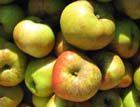Caring for Potatoes and Apples
David finds a bumper autumn crop keeps him on his toes finding the most successful ways to eat, drink and store his garden's bounty


I waited until the August bank holiday before lifting the first of our Pink Fir Apple potatoes. It is a main-crop variety, but I reckoned a few extra weeks in the ground after the drought in June and July would yield decent-sized tubers. It paid off, and we enjoyed a bowl of them dressed in Welsh salted butter and a good handful of chopped flat-leaf parsley. I'll dig the whole crop towards the end of September, or earlier if a frost threatens.
Against some advice, I find the potatoes store well if the tubers are dry, placed in a box in a single layer in a frost-free place and covered with a few sheets of newspaper to blacken out the daylight. The flavour is excellent to start with, but to my palate, it improves with keeping: they have become a tradition in this household at Christmas, eaten tepid (having first been dressed in olive oil and chopped red onion) to accompany Boxing Day cold meats.
Of the more popular 'waxy' salad potatoes (including Ratte and Belle de Fontenay), Pink Fir Apple has been around the longest. Raised in the mid 19th century, it was popular for a while with Victorian cooks and gardeners, but seemed to fall from favour as new and higher-yielding varieties were developed. Happily, seed remains readily available and mine were bought this year at a garden centre where such 'novelty' varieties would not normally have been found a few years ago.
Coriander is one of my favourite herbs: its incomparable taste essential in some curry and sauce recipes. It went to seed early (as did the rocket) because of the hot weather. But the seeds, when dry and crushed, lend a pungent, orange-like flavour to some dishes, and the addition of, say, a dessertspoonful ('fried' lightly in butter first) transforms an otherwise plain bowl of stewed apples into a gastronomic delight.
The glory of the fruit garden this year (leaving aside for a moment our bumper harvest of apples and pears) has been the thornless blackberry called Thornfree. Curiously, the birds have not robbed them this year, leaving us a newly ripened handful of glossy, jet-black, mulberry-like fruits every day in August. And with the early ripening of such apples as James Grieve (which were ready to eat in mid-August), the blackberries have enlivened a series of hot and cold apple puddings.
With recent news that a daily glass of cider may help to protect us against stroke, heart disease and some cancers, I have been careful to include one or two cider apples in our diet. Our orchard of 30 different apple varieties contains only one cider variety: Tom Putt. It is thought by Joan Morgan, author of the indispensable Book of Apples (Ebury Press, 1993) to have been raised in the late 1700s by either the Rev Thomas Putt, rector of Trent in Dorset, or by his barrister uncle, Tom Putt at Gittisham, near Honiton in Devon. It produces cheery-red fruits that vary in size from golf ball to tennis ball. However, when it comes to children's picture-book apples, none can compare to the bright sealing-wax gloss of a Devonshire Quarrenden, with its distinctive flavour of strawberries or 'winey to loganberry taste'. Possibly from Normandy (Joan Morgan, again), it was recorded in Britain as long ago as 1676. Some apples are good keepers that last into the New Year, but the Quarrenden is best eaten as it ripens, in early September. After that, it goes soft and the flavour deteriorates rapidly.
We are replanting many yards of herbaceous border, and the kitchen-garden beds, as they are emptied, have become a good refuge for the herbaceous plants we want to keep. Lifting them with as much earth around their roots as possible and heeling them into temporary accommodation means that we can rework the old beds thoroughly, rid them (or try to, at least) of ground elder and bindweed, and nourish them afresh with lashings of compost. We also are taking the opportunity to remove low branches from some of the overhanging trees. By comparing the borders with how they looked in photographs taken 10 years ago, we soon realised how much the shade has built up. And I'm against too much shade.
Exquisite houses, the beauty of Nature, and how to get the most from your life, straight to your inbox.
This article first appeared in COUNTRY LIFE magazine on September 7, 2006
Country Life is unlike any other magazine: the only glossy weekly on the newsstand and the only magazine that has been guest-edited by His Majesty The King not once, but twice. It is a celebration of modern rural life and all its diverse joys and pleasures — that was first published in Queen Victoria's Diamond Jubilee year. Our eclectic mixture of witty and informative content — from the most up-to-date property news and commentary and a coveted glimpse inside some of the UK's best houses and gardens, to gardening, the arts and interior design, written by experts in their field — still cannot be found in print or online, anywhere else.
